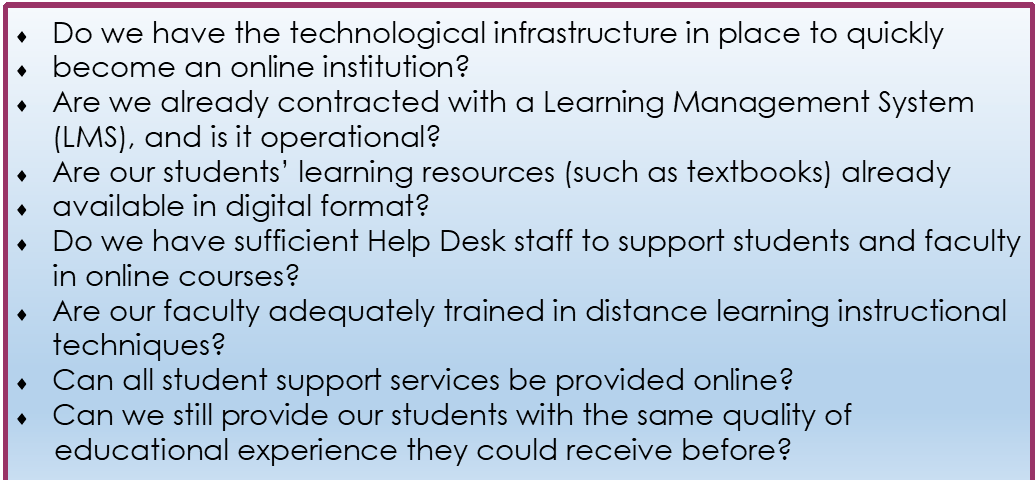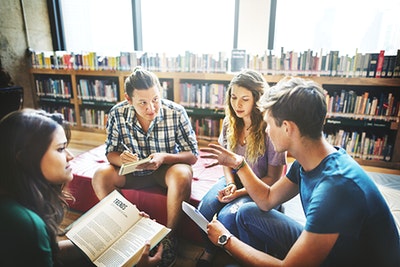Note: This article was updated on March 24, 2020 to reflect current closure data.
Nearly 300 colleges and universities across the United States have announced the decision to either shut their doors or transition their spring semester courses to an online format due to COVID-19 concerns. The number is rising, and quickly. It seems the most current list is being maintained by educator, researcher, and futurist Bryan Alexander, rather than official government agencies. Information is being crowd sourced and isn’t guaranteed to be accurate.
Normally, higher education institutions must get formal approval from their regional accrediting body in order to make such drastic changes. Staff must file a substantive change application; it’s thoroughly reviewed by the accreditor; and then a final decision is made by accreditation council members. This process can take 6-12 months. However, great latitude is being granted to institutions given the uncertainty and a landscape that seems to be changing daily.
Institutions Receive Unprecedented Approval
The US Department of Education released a letter “… providing broad approval to institutions to use online technologies to accommodate students on a temporary basis, without going through the regular approval process of the Department in the event that an institution is otherwise required to seek Departmental approval for the use or expansion of distance learning programs.” The Department has also permitted accreditors to “…waive their distance education review requirements for institutions working to accommodate students whose enrollment is otherwise interrupted as a result of COVID-19.” While this broad latitude has a shelf life and there are some limitations, this step is unprecedented.
And there’s more. For those institutions that may not already be well-equipped to move their face-to-face courses to a distance learning format, the Department says they may also enter into temporary consortium agreements with other institutions so that students can complete courses at other institutions but be awarded credit by their home institution.
It appears that even residency requirements that stipulate students must complete a certain number of credits at their home institution have been waived with the approval of the institution’s regional accreditor.
But Are They Ready to Deal with COVID-19?
Because of the COVID-19 crisis, the flexibility granted to colleges and universities by the USDOE and regional accreditors is huge. Without it, their hands would be tied and they’d be forced to close their doors leaving students in a lurch. However, that’s only the first step in what may seem like a marathon.
Granted, many institutions have been utilizing distance learning tools for several years and so while it may be challenging to transition and scale up quickly, they will be able to do so fairly successfully. However, for those institutions that up to now have only offered a few courses or even a single program online, they’d better be prepared to paddle upstream, and at lightning speed. Those 300 institutions currently slated to make the transition have a combined enrollment of approximately 4 million students.
Essential Factors for Higher Education Administrators to Consider
In order to make the best decision possible for students, university administrators should ask some essential questions before deciding whether to transition to a distance learning format, enter into a temporary consortium agreement with a sister institution, or close the doors completely until the Center for Disease Control gives the “all clear” sign for COVID-19. Examples include:

If the answer is “yes” to each question above, then leaders can feel fairly confident they will be able to successful weather the COVID-19 storm. If no, then administrators need to find another option. And quickly.
###
About the Author: Dr. Roberta Ross-Fisher has expertise in educator preparation, competency-based education, online teaching & learning, accreditation and quality assurance. A former public school teacher and college administrator, Roberta is now a freelance writer and educational consultant.
Twitter: @RRossFisher
Top Graphic Credit: rawpixel.com


3 thoughts on “COVID-19 & Higher Education”
Comments are closed.